| Author | Message | ||
| dubalbal
Advanced Member Username: dubalbal Post Number: 280 Registered: 10-2004 |
Hello Friends , I've seen a very few Alembic Series 2 with graphite necks . I really don't know how they sound , great i suppose ! These necks were made a long time ago and i was wondering how a series 2 could sound with a new and actual graphite neck ... I'd like to hear that anyway :-) Alain | ||
| serialnumber12
Senior Member Username: serialnumber12 Post Number: 734 Registered: 12-2004 |
You probably already heard this by Stanley playing his Graphite alembic,I think wooden necks sound best. http://www.youtube.com/watch?v=0nWA_Cipjpk | ||
| serialnumber12
Senior Member Username: serialnumber12 Post Number: 735 Registered: 12-2004 |
Here's another Graphite stanley tunehttp://www.youtube.com/watch?v=r7e3MyTCp78 | ||
| funkyjazzjunky
Senior Member Username: funkyjazzjunky Post Number: 567 Registered: 5-2007 |
I think graphite and active electronics add up to a clear but cold sounding bass VMG | ||
| terryc
Senior Member Username: terryc Post Number: 1192 Registered: 11-2004 |
Never been a graphite fan, useful if you are playing an outdoor gig in hot weather and high humidity but to me 'wood is good' Mind you if we were all blindfolded and asked to play two basses..one with graphite neck and the other with finished wood neck..could we really tell the difference?? | ||
| jimmyj
Intermediate Member Username: jimmyj Post Number: 189 Registered: 8-2008 |
As far as I know Alembic's experiment with graphite only lasted a short time in the early 80's so the basses produced were probably all Series I. They were "actual" carbon fiber graphite pieces laid out and cooked under pressure by Geoff Gould before he started Modulas. The basses were Alembic's standard neck-through design - with no truss rod - so they were structurally very stiff. The results were similar to playing a Travis Bean metal neck (anybody remember those?) - the dynamic range was reduced but the sustain was extended. As if you squashed the output with a compressor/limiter. I bought one of these basses at the time and used it for a while until I decided I missed the "effects" of wood. BUT, converting that bass to a fretless yielded excellent results. That combination makes a very natural and warm sound and the pre-compression and extra sustain work perfectly for what I was looking for in a fretless bass. I've used it regularly for 30 years. Man, I'm old! Jimmy J | ||
| 811952
Senior Member Username: 811952 Post Number: 1837 Registered: 10-2003 |
Back in the day ('81-ish), Vic Zinn Music outside of Indianapolis had several graphite-necked Alembics pass through his inventory. I'm positive one of them was a short scale KOA Series II, but I could be mistaken about that (it did have LEDs, of that I'm certain). The ones I played (and I played every one of them he had!) were all set-neck construction, a la Excel and Orion basses. Fine, fine, fine instruments! Vic also had an abundance of Modulus Graphite instruments (including the infamous 18-string monster), as well as some Rick Turner basses. John | ||
| dfung60
Senior Member Username: dfung60 Post Number: 413 Registered: 5-2002 |
Here's a couple shots of my Series II Graphite, probably one of the last few made. I have a very big collection of Modulus instruments and I *love* the sound of 'em. There's nothing better than the combination of graphite and Series electronics, although many of these old instruments can pose quite a challenge if they develop problems. You can tell the age of the necks by the appearance of the crystalline cosmetic graphite layer on the surface. The oldest ones sound the best and are the most tempermental. Mine is the polygonal finish which has a more reliable build quality but doesn't sound as good as the original ones that had a tiny crystal finish. I've got a bunch of Travis Bean basses too - I think Jimmy J's comment about a compressed tone is very true for the Beans, but I find that the graphite/Modulus necks are more of a wide ranging grand piano tone than the Beans which have a super thick bass tone. Those Beans are nuts - unlike graphite necks that don't care much about temperature, the aluminum necks go totally bonkers with the slightest temperature change. The crystalline and satin (wavy weave) graphite are much more piano-like than the checkerboard and polygon necks.   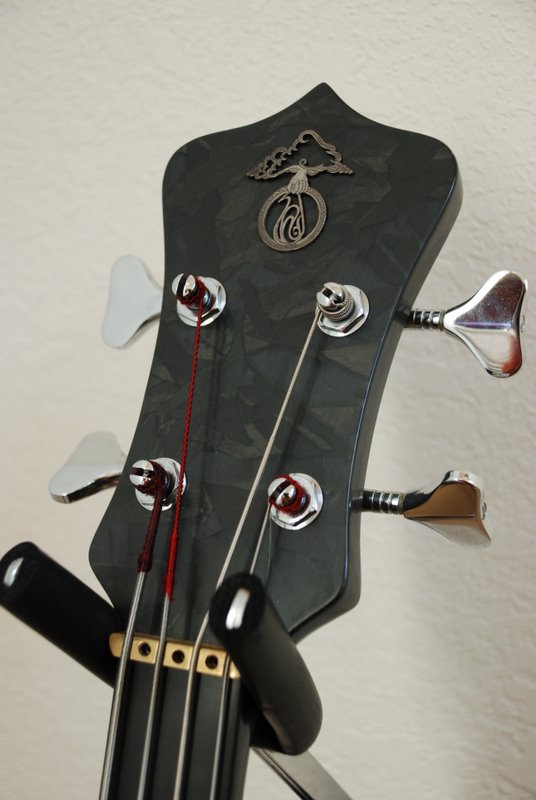  David Fung | ||
| sonicus
Senior Member Username: sonicus Post Number: 928 Registered: 5-2009 |
Very nice. Thanks for posting that . | ||
| davehouck
Moderator Username: davehouck Post Number: 9311 Registered: 5-2002 |
Very cool bass! | ||
| the_mule
Senior Member Username: the_mule Post Number: 773 Registered: 1-2004 |
Wonderful bass, thanks for posting these pics! Wilfred | ||
| terryc
Senior Member Username: terryc Post Number: 1195 Registered: 11-2004 |
I thought the graphite neck was all the way thru', that is a piece of excellent craftmanship to combine the neck so smoothly into the remainder of the neck thru. Very nice bass dave, very nice | ||
| cozmik_cowboy
Senior Member Username: cozmik_cowboy Post Number: 704 Registered: 10-2006 |
Aren't those wood veneers over the graphite after it hits the body? That's beautiful, though I must admit that for a second -just a second, mind you - I thought "What's that knob at the 9th fret, and how in the hell do you play with it there?" Always finish your coffee before you log on. Peter | ||
| terryc
Senior Member Username: terryc Post Number: 1197 Registered: 11-2004 |
Maybe it is the thumb string a la banjo!!!! | ||
| dela217
Senior Member Username: dela217 Post Number: 1030 Registered: 6-2002 |
I own a short scale Series II with a graphite neck. The neck definately goes all the way through the body. It's just hidden with wood. I thought it was a set neck too until I took the pickups out. The graphite goes all the way through. | ||
| terryc
Senior Member Username: terryc Post Number: 1198 Registered: 11-2004 |
Oh I see, nice veneers to cover the graphite. Nice touch but it is just what you would expect from Alembic. | ||
| 811952
Senior Member Username: 811952 Post Number: 1838 Registered: 10-2003 |
Neck through, eh? I stand corrected. I wonder if your bass is one I played at Vic's? John | ||
| dfung60
Senior Member Username: dfung60 Post Number: 414 Registered: 5-2002 |
Yes, the graphite neck is a full through-body, past the bridge and covered with wood plates on all sides ("ensconced in walnut!"). The necks are fabricated out of sheets of epoxy-impregnated graphite fabric in a custom mold, then cooked under heat and pressure in a gigantic autoclave to create the neck structure. You can't change the neck/body shape in any meaningful way after it's fabricated unlike wood. Figuring out how the part of the neck than runs under the pickups and into the body should be shaped so the graphite would show is too complex of a geometry problem, especially when these are being mated with different shapes of bodies, so the "body" part is built up to fit the instrument. Some of the early instruments have a graphite plate as the back cover of the shape, so you see graphite weave on the back. A "point" body like mine is gigantic, so the graphite stops past the bridge but a couple of inches before the battery cavity. On a short scale like Mike's, the graphite may be all the way to the battery compartment if it's not relocated. If you played this instrument, you would immediately notice that the neck is really narrow. There were different molds for 4-, 5-, and 8-string necks and in different scales. As was the style back in the late 70's or early 80's when the molds were made, then neck is really narrow and thick. Had I known this at the time, I would have had a 4-string built on the 5-string neck blank. The narrow width of the neck is why there are side laminates on the neck - I don't think most of the graphite Alembics have these. The way that the neck heel was shaped is sort of unbelievable and totally Alembic. A piece of walnut was bonded on to the graphite, and somebody hand shaped this thing with a grinder. The walnut is a soft hardwood; the graphite is like grinding a block of cement. You only get one shot or the whole thing is destroyed and this is perfect. This was part of why graphite necks went out of production. Graphite is hard to work on because you have to make a lot of final decisions before you fabricate the neck and many different tools and techniques are required. The neck blanks were fabricated at Modulus and sometimes the neck assembly was done at Modulus, other times at Alembic. There's a very high headache quotient here. I had this one built for me, so it's never been in a store. This bass was finished in 1987, well over a year in construction. By this point in time, the typical Series features were changing a bit, and I had them build this for me in the old style. I think a regular Series bass from that period had a slightly longer upper horn for better balance, but this is the original shape. Also, this instrument has a slightly thinner body than older and newer Series basses which I believe was also typical for that time and wasn't easily changed. Most of the new instruments had a gloss finish, but I went with old school matte on this (handling wear has made it part shiny, part matte today). It seemed like there was some evolution of the body shapes that was reversed back out by the 1990s. I was given one of the original Modulus through-body neck molds for a different bass (Moonstone). I'll see if I can dig it up and you can see what the graphite in the through-body section looks like. David Fung | ||
| musashi
Member Username: musashi Post Number: 77 Registered: 5-2004 |
I agree with Jimmy about graphite on a fretless. I had a Status Series II fretless and it was fantastic for solos. I also had a Travis Bean TB2000. It was the heaviest bass I ever owned. I did not find that it moved with temperature changes, though. It was solid as a rock. The problem was that it stayed as cold as an ice cube in the winters of Chicago, and didn't really begin to warm up until the gig was about done... It did have a pretty gnarly slapped tone, though. And the koa was beautiful. | ||
| bsee
Senior Member Username: bsee Post Number: 2445 Registered: 3-2004 |
I had a Modulus TBX 5 (carbon fiber neck-through) with quilted maple over alder and EMG guts. It sounded great through a MESA 400, but awfully lacking in character through any solid state rig. When it was stolen, they built me another TBX with cocobolo over mahogany and EMG DC guts. It was better, but still not soulful. I traded it on a Zon Sonus, and it was a vast improvement toward a sound that was pleasing to me. The lesson there is that the rest of the construction matters and you can't generalize about graphite. Also, as much as I love Alembic electronics above all others, I don't think any of the composite-necked basses I have owned would have sounded better with them. The clarity would have made the Modulus basses that much more sterile, and I think part of the character of the Zon comes from the Bartolini internals. The cleaner and more accurate Alembic guts might not sound as warm. | ||
| jimmyj
Intermediate Member Username: jimmyj Post Number: 192 Registered: 8-2008 |
Hey David, The back of my '82 looks a lot like yours except that all the electronics are in one compartment: 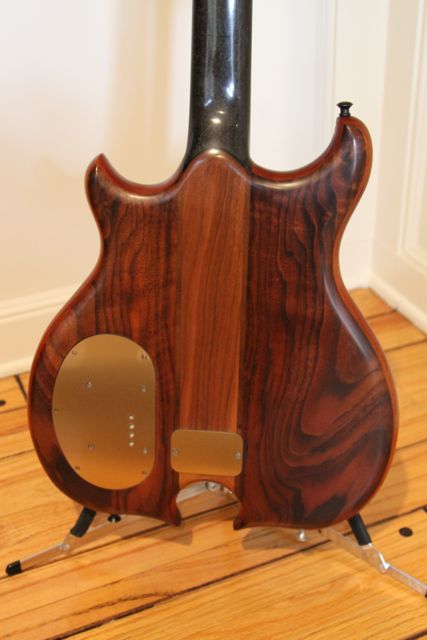 The front differs a bit though...  Here's my main fretless, 1980 vintage: 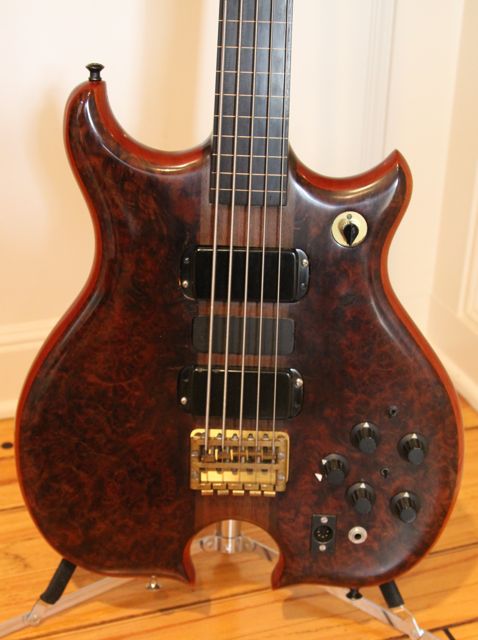 Oddly, you can see the neck on the back of this one: 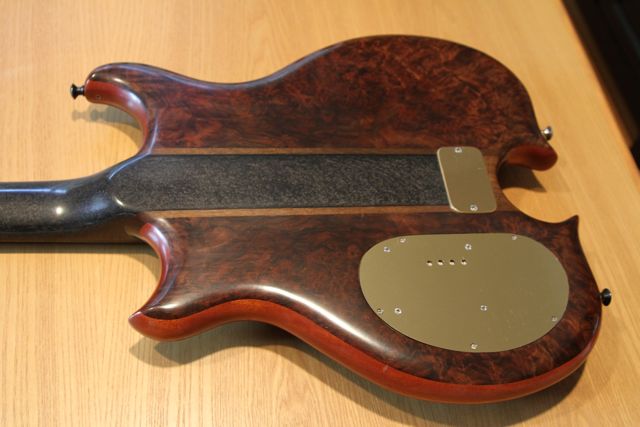 Plus, both these basses have a short "cone" headstock which I requested so I could fit them into the flight cases I still use: 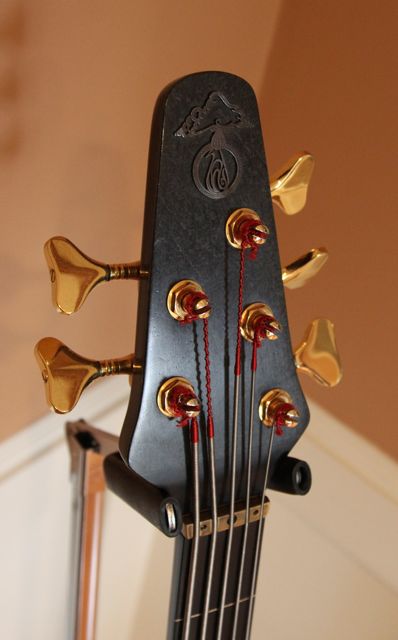 Bob, that's interesting about your two Modulas basses being so different. Certainly the rest of the construction effects the outcome and every single piece of wood is different from another. My 3 fretted basses are as identical as they could be but they all sound different - to me anyway. And the fretless basses share the same body woods but with graphite necks. The '82 began life with frets so I had a direct comparison to its otherwise identical wood-necked brothers. That's what led me to conclude that the compression effect I describe could only have been a result of the neck being a stiff beam of graphite. I would think that especially on through-neck instruments the neck material would have a huge effect. We'll have to get Mica to build some necks with no bodies attached so we know what's happening. Ha! When you use terms like "soulful", "character", and maybe even "warmth", it's like talking about professional audio gear: If you want to add "color" to the sound you get a Chandler Germanium preamp. If you want nothing added you get a GML mic pre, etc, etc. I think of the Series electronics as great sounding wide-band, high-gain, low-noise rigs. To me the basses sound very natural, almost like acoustic instruments. That's not what everybody is looking for of course, YMMV, but I'm completely stuck on the tone and have been fortunate to be able to fit the sound into many different musical situations. Cheers, Jimmy J | ||
| funkyjazzjunky
Senior Member Username: funkyjazzjunky Post Number: 573 Registered: 5-2007 |
Jimmy What kind of bridge is on those? (Message edited by FunkyJazzJunky on May 24, 2010) | ||
| tbrannon
Senior Member Username: tbrannon Post Number: 1182 Registered: 11-2004 |
Jimmy, I don't think I've ever noticed those bridge/tailpieces before. Looks like an Alembic bridge mounted over the top of a larger brass plate that works as the tailpiece? Care to explain? Toby EDIT: Vann beat me to it!  (Message edited by tbrannon on May 24, 2010) | ||
| jimmyj
Intermediate Member Username: jimmyj Post Number: 193 Registered: 8-2008 |
Nothing gets by my Alembic brothers! Yes, semi-experimental bridge/tailpiece combo designs on double size blocks. Here's a closeup of the '80: Note the crazy J shaped slots for the Superwound strings whose original "adjustable balls" were threaded brass tubes with two allen screws tightened from either side to pinch the string in the center. Combined with the semi-destroyed SLOTTED bridge mounting screws, bowing backplate and block trying to pull itself out of the bass, the whole thing looks pretty crude. But it has worked OK for 30 years... I tried again with the '82, which as you see was built for different strings: Only trouble here was that extra philips-head screw meant to hold the block down is anchored into wood in what is normally the battery compartment so the batteries are actually stuffed in with the board and wiring harness. That's what I get for going a bit crazy with the design ideas... Jimmy J | ||
| davehouck
Moderator Username: davehouck Post Number: 9329 Registered: 5-2002 |
Those are some beautiful woods! | ||
| pace
Senior Member Username: pace Post Number: 546 Registered: 4-2004 |
WOW JIMMY! Thanks for sharing those pics. Really, WOW! I really like your bridge designs!!!! But, why are the rail and intonation screw reversed on string 5 of your '82????  | ||
| afrobeat_fool
Advanced Member Username: afrobeat_fool Post Number: 207 Registered: 7-2009 |
Jimmy, Have you ever played a Hyak with the Graphite Laminates sandwitched between layers of wood? And if so, how different do you think they feel? I guess this question goes to all who might have both or played both types of instruments. These are some beautiful basses! Thanks for sharing! Nick | ||
| jimmyj
Intermediate Member Username: jimmyj Post Number: 194 Registered: 8-2008 |
Thanks Dave, yeah they used some nice pieces! Mike, I think the reason was because the end plate / tailpiece made it too difficult to get to the intonation screws, even with a ball driver, and there was slightly better access from the pickup side. Then if I remember correctly, the B-string saddle ended up so close to the frame of this contraption that there wasn't room for the tuning screw nut, so they had to swap the rail and screw positions for only that saddle... Crazy! Jimmy J | ||
| bsee
Senior Member Username: bsee Post Number: 2447 Registered: 3-2004 |
Jimmy, I know it's tough to use those subjective terms. There's a certain tonal characteristic associated with a guitar or bass. I was traveling when I came across the first Modulus and made the mistake of demoing it through a Mesa 400 and 2x15 cab. The rig had so much color that it hid the fact that the bass had none of its own. Even unamplified, the instrument would sustain for days, but the tone was uninspiring. It was after that experience that a primary test of any new instrument for me was born. I universally stick my ear to the body of the instrument and play. If I like that sound, then I probably have a winner. If I don't, then no amount of electronics are going to make it right. They can make it workable, but they can't make it right. | ||
| jimmyj
Intermediate Member Username: jimmyj Post Number: 195 Registered: 8-2008 |
Nick, no, I don't think I've ever seen a Hyak in person but they look pretty interesting. Graphite as a structural laminate makes sense - stiff but still mostly wood. No truss rod is a bit scary though. Your initial action setup decisions need to be kinda permanent... Jimmy J | ||
| jimmyj
Intermediate Member Username: jimmyj Post Number: 196 Registered: 8-2008 |
Bob, thanks. i understand and completely agree with you, the instrument must have a sound WITHOUT an amp. You can tell all about it, dead spots, sustain, general tone or growl, just by hearing what it does in your lap. As I said, I didn't very much enjoy the '82 bass above when it had frets but as a fretless it's pretty great. Jimmy J | ||
| afrobeat_fool
Advanced Member Username: afrobeat_fool Post Number: 208 Registered: 7-2009 |
I hadn't really thought about it in that way. With the mothership working on mine I have a unique opportunity. I did not mean to interupt this thread. Thanks Jimmy! | ||
| dfung60
Senior Member Username: dfung60 Post Number: 416 Registered: 5-2002 |
Jimmy - Awesome shots! I remember seeing your fretless at Modulus back when they were on Folsom in SF (it seemed like it was there forever). It's an extraordinary bass. I never got Geoff to admit whether he thought this was better than his personal Alembic, but I know it sounds better than mine. The different generations of Modulus necks have distinct differences in tone. The oldest ones have the crystalline cosmetic coat that both these basses have. After that there was a kind of wavy woven fabric, then checkerboard weave, and finally the polygons that are on most Modulus basses and on my Alembic. The outside appearance is cosmetic - the molds are build up in layers in a mold, and the first layer in is the one you see on the outside. The actual guts of the neck have a boring linear appearance. The polygon necks are made by chopping the linear material into irregular shapes and laying those in the mold. I think the old crystalline necks are stiffer and have a more "piano" tone. The polygon necks benefit from years of building them, so they're much more reliable - the old ones often suffer fatal delamination (literally coming unglued at the bonding faces between the structural pieces of the neck). Mere epoxy can't bear the stress of holding two pieces of invulnerable graphite together. Geoff pooh-poohs the differences between old and new necks (like any builder, the latest one he built is always the best), but I think it's pretty obvious when you listen side-by-side. The older necks were overengineered which isn't suprising since they are literally coming from the same hands that built satellite parts when composite parts were unobtainium. The linear graphite used was a stiffer, more expensive material, and I think most of those crystal necks were fabricated by Geoff himself (I guess his stray beard hair provided additional structural stiffness in the matrix). I have a couple of oddball multi-string basses which were also built from the higher stiffness graphite because they can't predict how the regular stuff will bow with extra string tension and they sound different too. The checkerboard necks sound exactly like the polygons. I know I saw photos of a checkerboard Alembic here before. Love the hardware! I love the Superwound strings too, although I never tried them on the Alembic (these are the strings where just the core runs over the bridge which really requires a different sort of bridge and setup). David Fung | ||
| dfung60
Senior Member Username: dfung60 Post Number: 417 Registered: 5-2002 |
Since we're talking about it, here's a picture of Geoff Gould's personal graphite Alembic. I don't have a better picture of the whole instrument or the back. I remember the sound and feel were amazing. 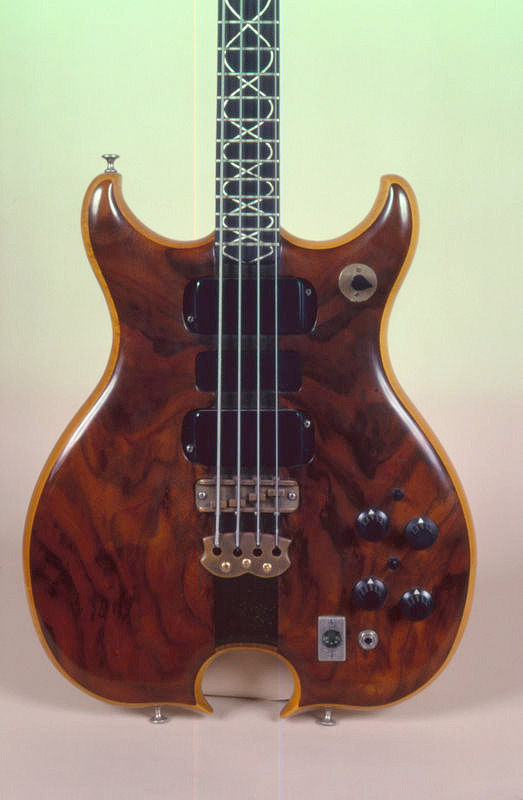 The sine wave inlay is sterling silver. Unfortunately, Geoff doesn't own this instrument any more, but probably would like to find out who owns it now. When I found out he sold it, I was kind of miffed I didn't get a chance to buy it although I guess it would never really have been "mine". I hate to think of it hanging in a store somewhere with people saying "hey, is this neck made out of plastic or something?" David Fung | ||
| bigredbass
Senior Member Username: bigredbass Post Number: 1398 Registered: 9-2002 |
Jimmy and David: Back in the day, I came real close to buying an original Steinberger. Ultimately, I didn't but I always remember one thing about them and wondered if the graph Alembics and Modulus' were the same way: The Steinberger was almost eerie in that every note sounded exactly the same the length of the neck, no dead spots, and very little of that string-length-is-getting-shorter woody honk that you sometimes hear. Are these the same way? THANKS for the history lesson! J o e y | ||
| sonicus
Senior Member Username: sonicus Post Number: 987 Registered: 5-2009 |
From aesthetic standpoint I can relate to the appeal to this instrument_ Very Cool____. If only I could reach into my Computer monitor screen and pick it up and play it _ | ||
| dfung60
Senior Member Username: dfung60 Post Number: 418 Registered: 5-2002 |
Posting madness! I don't have a Hyak, but I have a Moonstone bass that has some signficant graphite plates in the neck laminations. The four dark stripes are graphite - two thick ones and two thin ones. This instrument does have a truss rod.   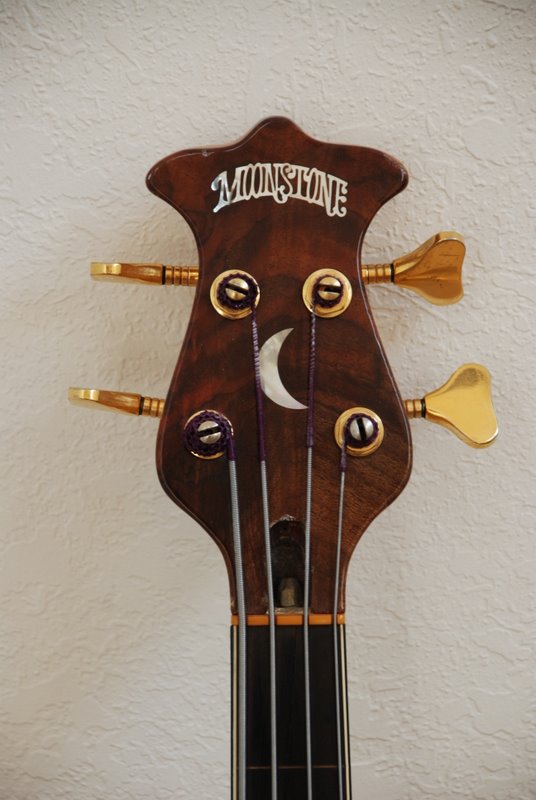 This bass is probably almost 30 years old now. One of the coolest things that I like about old instruments made of exotic woods is that the long-term shrinkage of the wood makes for a ripply varnished surface. On this bass, the burl on the face and back is nice and ripply, and you can really feel the graphite laminates sticking out out of the back of the neck, relative to the wood. I'm sure that the graphite stiffens the neck, but the character of sound of this instrument is like wood, not graphite. It was converted from fretted to fretless. It's a bit of an odd bass with a very thin neck and huge body. This is also heavy - just over 10 lbs. David Fung | ||
| davehouck
Moderator Username: davehouck Post Number: 9335 Registered: 5-2002 |
Love the symetric body and cool top on Geoff's bass. The Moonstone is pretty cool too! | ||
| sonicus
Senior Member Username: sonicus Post Number: 988 Registered: 5-2009 |
Oh thanks for the pics of this Moonstone as well! Are the pickups Bartolini? Are they #9W4 ? or ?? | ||
| dfung60
Senior Member Username: dfung60 Post Number: 419 Registered: 5-2002 |
The Moonstone pickups are Bartolini (I don't think I've ever seen a Moonstone bass that doesn't have Barts). I don't know the Bart models very well, so can't attest to what they are. Looks like standard Jazz-sized pickups, but the bass doesn't hum when one pickup is on, so they may be stacked humbuckers. Magnetic viewing paper shows one wide bar magnet in each pickup. Both pickups sound deep compared to a Fender Jazz. I never looked in the control cavity before, but it's pretty unusual in there - the wood was left intact in the center of the compartment (Steve Helgerson showing off, I guess!): 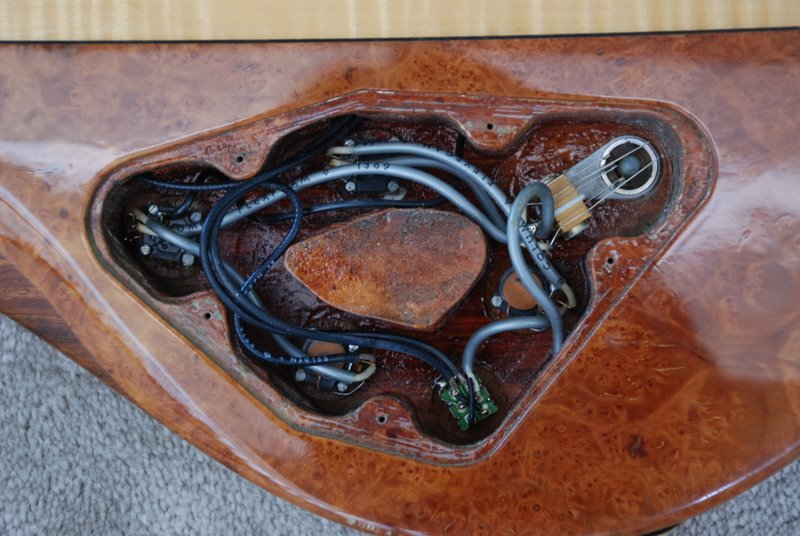 The wiring is volume/tone for each pickup. This is a passive bass, no battery or EQ. The mini switch is a dual tone for the bridge pickup (so the two pickups aren't the same). There's a pickup selector that follows the volumes and before the output jack. I'm a little embarassed to admit that I didn't know what the mini-toggle did before looking back here. This is a fretless conversion and the neck pickup is worn into smooth, shiny ridges from string contact. I couldn't take a picture of that. David Fung | ||
| jimmyj
Intermediate Member Username: jimmyj Post Number: 197 Registered: 8-2008 |
David F, Very cool, thanks for the interesting history of graphite and Alembic. And for posting these other axes, you must have quite a collection! Geoff's bass is really cool too. Judging by the pickup spacing I'd guess it's a short scale? I can't believe he doesn't still have it... I think my '80 was a pretty early one. I believe it was the 4-string mold as the nut is only 1-1/8" wide. (All my basses are essentially 5-strings on 4-string necks - just what I'm used to.) It's also very thin under the nut, only 1/2 inch of graphite between the bottom of the fingerboard and my thumb. if I remember correctly, trimming it down left several linear inches under the fingerboard that are solid graphite instead of a hollow trough. I can't think about how rare the instrument is or I'll loose my mind and never take it out of the house. Each Alembic - or probably ANY brand - is unique. We know wood varies but now we know that graphite varies. I suspect even aluminum does for your Beans! So when you get a great axe you have to treat it like your kid! J o e y, the resonance of an instrument certainly changes with the material but there is almost always some note that can't quite sing like the others for whatever reason. Sometimes if you rap your knuckle on the body and hear a pitch, THAT will be the note that gets swallowed when you play it (or feeds back when you crank it up). These graphite basses are very even and as I said almost pre-compressed. I would say any dead spots on mine are at least in different locations than on their wood counterparts. And the same note on the next string over works fine! Nice thread! Jimmy J | ||
| sonicus
Senior Member Username: sonicus Post Number: 990 Registered: 5-2009 |
I like this Moonstone . The reason I ask if they were Bartolini model 9w4 because I have them in a passive fretless Jazz Bass that was put together for me by Jerry Dorsch who was the co- founder of Modulus. The neck was originally a Paul Chandler lined fretless bolt on design. Jerry completely refinished it for me and then coated the surface of the rosewood fingerboard with an epoxy like coating . He is really a master at such coatings .The 9w4 uses 4 discrete coils resulting in a very quite signal. I believe that the 9w4 is no longer manufactured. | ||
| dela217
Senior Member Username: dela217 Post Number: 1031 Registered: 6-2002 |
Here is my graphite bass from 1981. 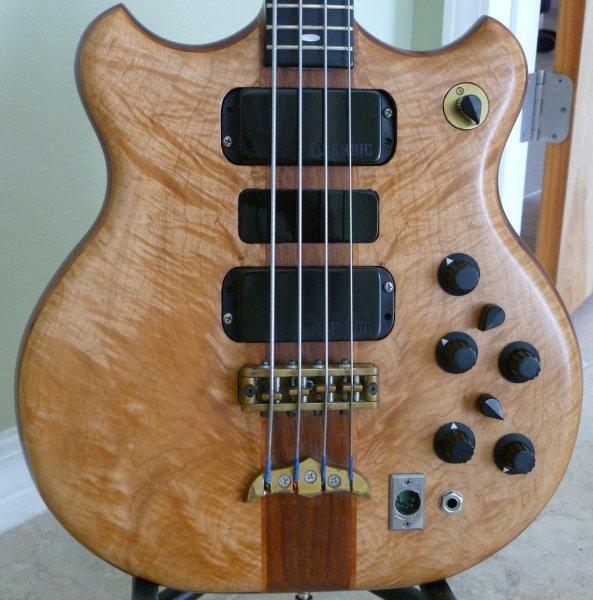 I've had this bass for about 10 years now. I'll have to admit the sound takes some getting used to. I also find that the strings on this bass makes quite a difference in how it sounds. I use mostly flats on my basses, and right now I am using the D'Addario Chromes on this one. To me this bass sounds best with a set of D'Addario Slowounds on it. But, of course those are discontinued. Anyone know of something close to the Slowounds?? | ||
| dela217
Senior Member Username: dela217 Post Number: 1032 Registered: 6-2002 |
Here's the back. To me the maple with the koa lams is just beautiful on this bass. 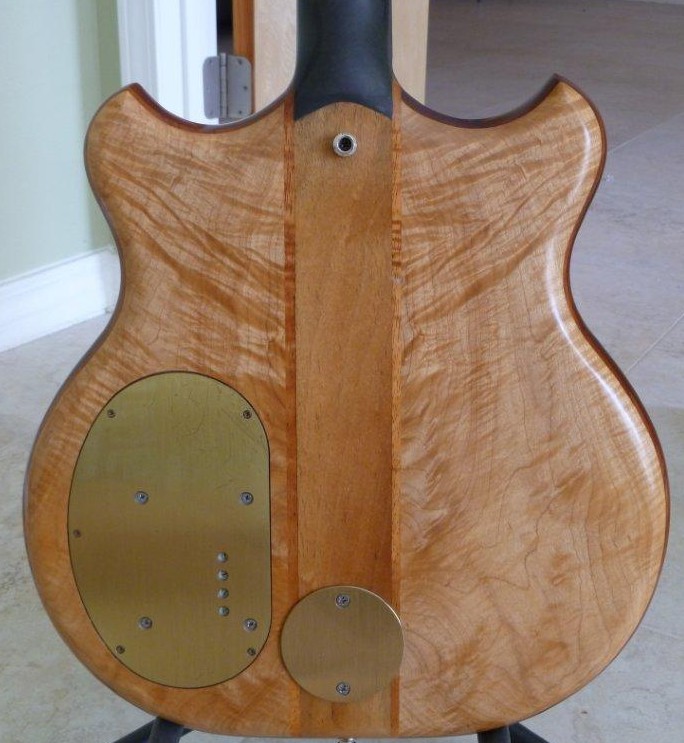 | ||
| dela217
Senior Member Username: dela217 Post Number: 1033 Registered: 6-2002 |
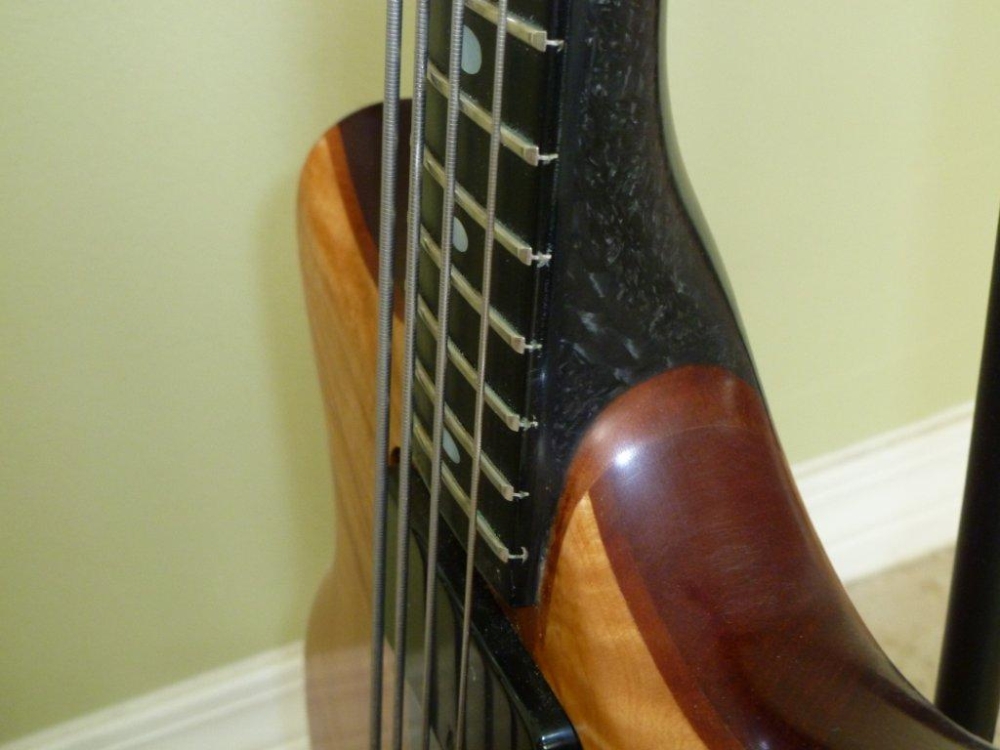 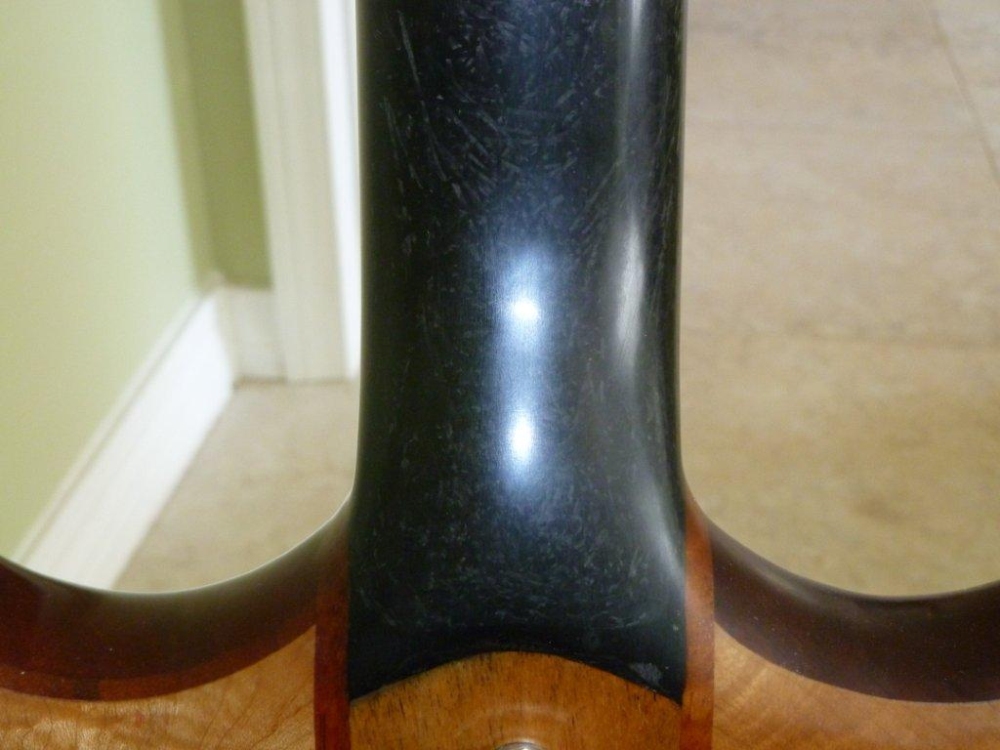 | ||
| dela217
Senior Member Username: dela217 Post Number: 1034 Registered: 6-2002 |
Being a Series II, it has the bookmatched to center headstock veneers.  | ||
| davehouck
Moderator Username: davehouck Post Number: 9345 Registered: 5-2002 |
I love the figuring on the Maple! Beautiful bass! | ||
| sonicus
Senior Member Username: sonicus Post Number: 1004 Registered: 5-2009 |
Oh yes , Beautiful. | ||
| artswork99
Moderator Username: artswork99 Post Number: 1138 Registered: 7-2007 |
Thanks for the fabulous eye candy! | ||
| jimmyj
Intermediate Member Username: jimmyj Post Number: 198 Registered: 8-2008 |
Yeah Michael, real nice! That's a short scale? Jimmy J | ||
| dfung60
Senior Member Username: dfung60 Post Number: 420 Registered: 5-2002 |
Michael - Your Series is awesome! What's the scale on this one? It's interesting that the battery plate isn't inlaid. Do you still have the black graphite too? It's funny that you mention liking Slowounds. I generally am not really crazy about D'Addario bass strings, but I loved those as well. At the time the discontinued them, I remember the story was that they transitioned the XL production to use a similar technique, so the more expensive Slowounds didn't make sense. But they XLs don't sound at all like the Slowounds to me. When I had my graphite S2 built, I was trying to get everything done in "the old way" - class body shape and cutaways, matte finish. But I think some change had been made where the bodies were slightly thinner and this necessitated the second circuit board on the "top" half of the body. I haven't been in there a while, but the regular cavity is pretty jam packed (at least 4 regular basses worth of wiring). The upper cavity just has the preamp board mounted to the plate. Plenty of extra room for a future Series III upgrade, eh? David Fung | ||
| dfung60
Senior Member Username: dfung60 Post Number: 421 Registered: 5-2002 |
[Whoops, saw a typo, too slow on the cancel button. Just disregard this! - DF] (Message edited by dfung60 on May 26, 2010) | ||
| dfung60
Senior Member Username: dfung60 Post Number: 422 Registered: 5-2002 |
Jimmy - Your description of your '80 neck profile is interesting. Mine is very narrow and very thick with little increase in width toward the bridge. Sort of starts out like an old EB-3 and stays that way up the neck. It's weird but comfortable. It looks like Michael's is pretty narrow too. The necks are fabricated with a U profile, but the top is milled flat. The amount that's milled affects the thickness of the neck. I've seen a number of them where the area up to the 3rd fret ends up being solid. I guess that's good since it increases the gluing area where the neck is most vulnerable. If the monocoque neck shell is too thin, then there's not enough bonding face at the edges. I've been told this is why early necks had more delamination failures. At the risk of causing you to lock your bass in ta vault, I'm fairly certain that Geoff referred to your bass as being the very first 5-string electric bass with a low-B. Maybe my memories are scrambled on this. I can't really remember when I first started seeing 5-string basses with a low B. My first 5-string was a Modulus in the late 80s. David Fung (Message edited by dfung60 on May 26, 2010) | ||
| dela217
Senior Member Username: dela217 Post Number: 1035 Registered: 6-2002 |
By the way guys, my graphite bass has a hollow headstock. Are they all that way? I removed a tuning key once to put on a D-Tuner when I noticed it. | ||
| serialnumber12
Senior Member Username: serialnumber12 Post Number: 745 Registered: 12-2004 |
wow Hollow headstock? .......hey mike whats with your "katrina basses" (Hurricane) are they being worked on at this point & how many did you send to alembic for repairs? | ||
| room037
Advanced Member Username: room037 Post Number: 319 Registered: 9-2003 |
I'm in ! I mention several words about graphite neck. 1: When the first graphite Alembic was made ? "The Long Story" said first 2 graphite were made for Stanly (black bass ?) and Mcvie at 1976. But J.Entwistle's 4 string Scorpion has No. 75' A043. ??? 2: When the last graphite Alembic was delivered ? There is 89' graphite exploiter in the archive of Station Music. Hi David Fung, When your graphite was made ? 3: The sounds of Graphite neck. When I got my first graphite (ex' Michael's black 5 strings), I loved the clarity of sounds. The bass has maple (solid) body and replaced Mac. Ebony top and back. But I know each Graphite instrument has different sounds when I got my next graphite. My shorty graphite is made of Koa and Mahogany wood and has fat midrange sounds. I am very interested Jimmy's relative comment "the sound fit for fletless". I also own Hyak (but guitar). I can't speak about the sound relatively. I only think the graphite layer is not effective than "no truss rod". By the way, the combination tailpiece of Jimmy's basses are effective for the sounds or not ? 4: My 5 strings Graphite My 83' 5 strings has same head as Jimmy's, but neck is slightly wide on bridge side. (You can see the wider bridge) I think the mold were different. And the neck is very thin, because thinner or single layred fretboard. I don't know such fretboard on another graphite. Hi Michael, The headstock of mine (not me! ha ha!) is hollowed. Hi Jimmy, Why you change the location of the upper horn strap pin ? (Your preferable position is inside of the horn for a long time, isn't it ?) Eiji | ||
| keith_h
Moderator Username: keith_h Post Number: 1619 Registered: 2-2005 |
Wow Michael. When we talked about the characteristics of the graphite necks a couple of years back I didn't realize how nice yours looks (I was looking at a different bass at the time). It's a definite keeper but if you ever ..... Keith | ||
| senmen
Senior Member Username: senmen Post Number: 978 Registered: 7-2003 |
Guys, and really not to forget John Entwistles graphite neck 8string Spyder....... Oliver (Spyderman) (Message edited by senmen on May 27, 2010) | ||
| gregduboc
Senior Member Username: gregduboc Post Number: 433 Registered: 11-2008 |
I love the feel and sound of a graphite neck. You guys have unbelievable beautiful basses. I just ordered a Status Graphite to suit my need for a bit of graphite in my life! I wish Alembic still made them... Here are some shots I have saved of the bass Eiji mentioned:  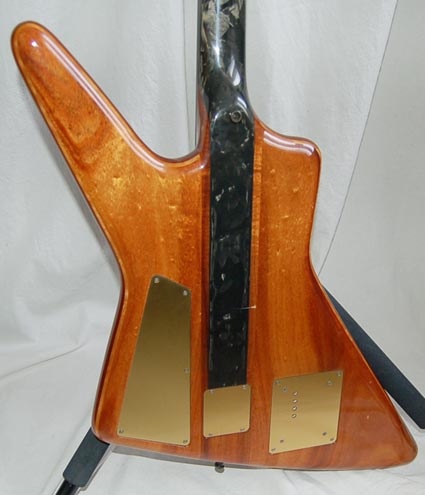 It is my dream bass. The best electronics, the best shape (for me!) and graphite! I wish it was for sale... Greg | ||
| jimmyj
Intermediate Member Username: jimmyj Post Number: 200 Registered: 8-2008 |
Some real exotics here! Eiji, you have quite a collection of basses and may know more about Alembic's Industrial history than any of us. To answer your two questions to me; #1, Yes, I imagine my bridge/tailpiece combo units must have an effect on the sound, not to mention the double blocks underneath. So any generalizations I have made about graphite may be moot! Ha! #2, I have had the strap button at the end of the horn for a long time but it may have been inside the horn on my '76 - that was before I knew about strap-locks... As a curiosity, I also use the button nearest the 5-pin connector for the other end of the strap. Not sure if that's normal or odd. Jimmy J | ||
| dfung60
Senior Member Username: dfung60 Post Number: 423 Registered: 5-2002 |
All the Modulus necks have hollow headstocks. The composite material is heavy and expensive, and there's an engineering elegance that comes from achieving the design goal in a minimalistic way. Like the main part of the neck, the headstock has a plate of graphite epoxied to the top of the main neck piece. If you crank down on the tuning head main nut too much, you may be able to crack the headstock face (so don't do that!). David Fung | ||
| dfung60
Senior Member Username: dfung60 Post Number: 424 Registered: 5-2002 |
Eiji - Both Geoff Gould and Rick Turner have told me that they thought the first graphite Alembic went to John McVie. Fleetwood Mac was the biggest band in the world at the time, and they were in Northern California at that time, not far from the mothership. My graphite Alembic has a 1987 serial number. It took a long time to build (more than a year if I remember correctly). I live in the Bay Area, and I think saw the raw neck blank at Modulus in SF (Modulus was a contractor to Alembic, so they don't know anything about the final instrument, but there weren't many of these). I picked the walnut top and back at Alembic, visited it before the neck and body wings were joined to talk about the omega shape, and picked it up when it was done. David Fung | ||
| dfung60
Senior Member Username: dfung60 Post Number: 425 Registered: 5-2002 |
Joey - Sorry, didn't see your message asking about Steinberger amid the stream! I'm a big Steinberger fan too (I'm one of the moderators of the Steinbergerworld e-mail group) and have a bunch of Steinbergers of various vintages. I had most of these basses before I got married - I would call them a "collection" although my wife calls it an "affliction". The construction of Modulus necks is really different than Steinbergers. The Modulus neck is laid up from graphite cloth that's impregnated with epoxy, then it's cooked under heat and pressure in a big autoclave (the size of a small car). The finished neck is hollow which is a strong structure from the physics standpoint. Geoff Gould worked at Ford Aerospace building satellite parts so his techniques and materials carried straight over to guitar necks. The Steinberger neck is a solid casting of resin that has a backbone that's made of graphite fabric and kevlar. The (small) body of an L2 or XL2 is hollowed out (it looks like a TV dinner tray in there) to keep the instrument from being too heavy (most people are suprised at how heavy a Steinberger is when they first pick one up). The construction technique was developed by a consultant who made power boat hulls. There's no "better" or "worse", just different. If you played a Steinberger and a Modulus with the same EMG pickups, you'd definitely hear the difference. The Steinberger sounds more like wood, and the Modulus has more high end. Both are much more even across the neck than wood instruments. The Steinberger is so different than a J-Bass that it can't help but sound different. The Steinberger is much stiffer and denser than maple, it's a through-body, it's headless, and has really massive hardware. Wood neck guitars don't suffer too badly from the "wolf-tone" problem, but the resonance frequency of a bass neck is in the audio range of the bass' notes, so when you hit one of those notes, the neck just swallows up the energy and you get a weak note. The composite instruments are a lot stiffer, so the resonant frequency is shifted up, you don't get the dead notes, and the instrument sounds much more even across the range. Laminating a wood neck or adding ebony laminates similarly affects the stiffness and resonance and changes the sound. In theory, the wood necks will vary from neck to neck because each piece of wood is different and composites should all sound the same, but in practice there's so much handwork in a Modulus or Steinberger neck that they all end up having individual voices as well. I've got a bunch of L2 basses (the original model) from different factory locations (Brooklyn, Newburgh), and I can tell them apart by sound, although they feel exactly the same. FYI, the Status basses from England are similar in construction and materials to Modulus and the unplugged sound is very similar. Their process is more modern then Modulus so they can make more complicated shapes. The Moses Graphite necks are a cast structure more like the original Steinberger. David Fung | ||
| dfung60
Senior Member Username: dfung60 Post Number: 426 Registered: 5-2002 |
Oliver - At the risk of starting you off on a treasure hunt, there was a small b&w picture of Entwistle's 8-string graphite Spyder on the Questions page of some issue of Guitar Player, before Bass Player was a separate magazine. Sorry, I don't know when it was! Entwistle had Modulus-necked instruments made for tours where the arena conditions made it impossible to maintain his super-low action. I played around with one of his prototype Warwick Buzzards which was sent to Modulus for "duplication" in graphite and as a donor for hardware. When I picked it up, it buzzed on every note and I assumed that the setup was messed up, but it turned out that this one had been carefully set up to his stage preference. Modulus necks didn't have a truss rod back in those days (this was by design - only graphite carries the structural load and sound), so the action had to be established in the finishing of the fingerboard and frets. I played the first finished Modulus Buzzard and they copied it so closely that I couldn't play that one either. That one wasn't quite right for John either, so they ended up making another one to replace it (that's the green one in Bass Culture). I had an opportunity to buy this first green Modulus Buzzard, but decided that I was never going to have enough game to go out in public with a Buzzard, especially one that I couldn't play! This Buzzard got signed by John and was a Bass Player equipment giveaway. That 4-string graphite Exploiter is really awesome! This isn't one of Entwistle's is it (no cobwebs)? Who is Lothar? Station shows it as a 1989 bass, so this must have been close to the end of the line. David Fung | ||
| adriaan
Moderator Username: adriaan Post Number: 2496 Registered: 6-2002 |
AFAIK, Lothar is the guy behind Station Music, and the koa/graphite Exploiter is his personal bass. | ||
| tbrannon
Senior Member Username: tbrannon Post Number: 1183 Registered: 11-2004 |
Fascinating discussion. I have nothing to add, but I'd appreciate it if you guys could keep talking because I'm learning quite a bit. | ||
| dela217
Senior Member Username: dela217 Post Number: 1036 Registered: 6-2002 |
Afrobeat_fool, Dfung60 - The Hyak feels and sounds like a whole different animal. They Hyak exhibits both the positives of the wood and graphite. My Hyak is (was) quite warm sounding, with piano overtones. It's a slap monster! It has the same type of neck construction as the Moonstone, except with more laminates. The neck recipe on my Hyak is not like any others I've seen. Mine has 8 graphite laminates, but it is a 32 inch scale. All other Hyaks I've seen only had 4 laminates but were long scale. Perhaps they used more laminates in the shorter scale neck? Here is a pic of the back of the neck. You can clearly see the black graphite laminates.  Here is the rest of the bass: 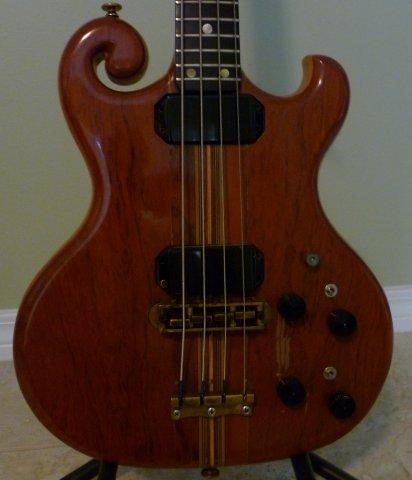 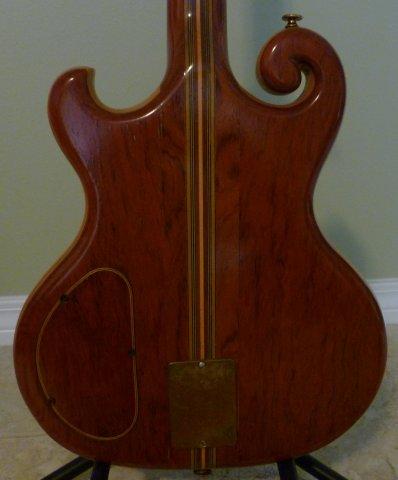 Earlier in this post I mentioned that my Hyak was warm sounding. It still would be if the electronics still worked! You see, this is one of my basses that were flooded. The electronics worked for about 4 years after the soaking in salt water. But it finally gave up a couple of months ago. It may be a simple fix, but I have not looked into it too much. The preamp cards and filters still seem to work. But, when I plug a 5 pin cable in I get mostly a 60 cycle type hum. The way these electronics work is that there are 2 preamp/filter cards and another card that sums the 2 signals. I suspect the problem is with the card that combines the signals of the 2 preamps from what I can tell. Michael | ||
| bigredbass
Senior Member Username: bigredbass Post Number: 1400 Registered: 9-2002 |
Thanks, David, and now the other question about Steinbergers, perfect since you have several: Did they all come with that baseball-bat neck profile? The several I tried that ran me off seemed to have used a 2" pipe sawed in half as a neck mold. I too was surprised at the weight. And of course, being sold to Gibson killed it eventually. I'm like the rest of us: This is all fascinating! It's always a hoot to see these one-offs. J o e y | ||
| dfung60
Senior Member Username: dfung60 Post Number: 428 Registered: 5-2002 |
Joey - The original Steinberger bass model was the L2, which has the thick and round profile you mention. The later model is the XL2, which is an evolution of the original design (evolution is not necessarily good though). It has a more traditional neck thickness and has "sharper" edges of the fingerboard, but it's not like a Fender-style neck. I bought my first L2 new around 1982 or so, right after they stopped being impossible to get. It was my main bass for many years. Switching off to a tradtional bass isn't too bad, but switching between the L2 and a Series bass challenging - everything is totally different - almost no body to giant body, how it hangson you, and carrying a little gig bag instead of an aircraft carrier-sized hardshell! David Fung | ||
| afrobeat_fool
Advanced Member Username: afrobeat_fool Post Number: 214 Registered: 7-2009 |
Michael, thank you for the pic's and info about the Hyak. You were very helpful to me back on '02. We talked on the phone for over an hour back then. Is that the original tailpiece on your shorty? Since that time my Hyak was stolen, but I found another and The family is going to bring it up to snuff with new p-ups, bridge, nut, etc. The reason I am saying this is because they are going to make new stuff and some of the work might be applicable to your situation. And, if you ever want to sell that shorty.......Call me first! nick | ||
| dela217
Senior Member Username: dela217 Post Number: 1037 Registered: 6-2002 |
That is the original tail piece on that bass. What I did change though were the brass screws that hold it in place. I used some stainless steel ones to replace the brass ones. I've had the brass ones fail on me on other basses. Michael | ||
| eligilam
Advanced Member Username: eligilam Post Number: 257 Registered: 2-2006 |
Pardon me if this is veering off topic too much...my SCSD is my main bass, but I'm also in love with my 1984 Steiny XL2, acquired last August. My question is for Mr.Fung: Since getting the XL2, I've been considering tracking down an L1 or L2 (however, most showing up for sale are usually beaten up pretty bad, it seems). I know it's subjective, but are the XL2/L2 differences great enough to have both in the arsenal? Thanks in advance! | ||
| dfung60
Senior Member Username: dfung60 Post Number: 429 Registered: 5-2002 |
eliglilam - The L2 and XL2 have a pretty similar tone, but feel different to play. The L2 neck is thicker and rounder. The L2 bridge is milled steel vs. the cast zinc of the XL, but both work pretty well. This is more of a tactile issue. Most L2s have an EMG pickup which was designed for this bass and which is only available as a factory special order now (the EMG-SS). The difference in tone is noticeable. Inside the EMG case, Steinbergers have P-bass pickup guts, 4 string on earlier L-basses, and a 5-string P-like pickup for later models. L2s are pretty common. You'll have a challenge finding an L1 as they are extremely rare. I happen to have one and posted pictures on the Steinbergerworld e-mail group when somebody suggested that they didn't really exist. That's my L1 in the American Basses book. We have almost 2000 people on the group, only 3 L1s have emerged. David Fung |